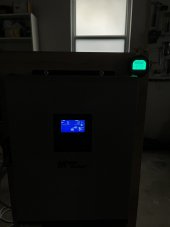ender
New Member
- Joined
- Jul 3, 2021
- Messages
- 16
Melted plugs? Which plugs? 60A on a 24V system would equate to roughly 15A at the 120VAC input to the MPP Solar box which is right at the limit of what a typical 12AWG extension cord is rated to handle (20A at 60C). On the battery side, I'm using 4AWG wire as recommended by the MPP Solar manual which is rated to handle 70A at 60C. In other words, if you use the correct gauge wire as recommended in the MPP Solar manual, you should be fine.It is interesting, and I think important information. But I would not be hasty to go to 60A because I did one day when I was in a rush to top of my batteries before going boondocking and I wound up with melted plugs. In fact, even when I bump my MPP 2424LV up to charge at 30A the plug gets a bit warm. I have found that at 20A everything seems to be just fine. So it amazes me when I see folks saying "40A for every battery" or some such thing. I don't know the technicalities of the process, and I could be wrong, but I think if you start bumping the amperage up to 60, 80 or even 100A you could wind up with some very unpleasant and unexpected results. (My system: MPP 2424LV with 10ga cable handling the AC in and out, SOK 12V 100aH x 6, Renogy 100W panels 3S2P, Honda 2200i.) It's all a learning process and I'm glad to have a forum like this to glean all the info I can and hopefully continue to refine my system.
That said, the real reason I wouldn't set it to 60A would be because you'd be charging the batteries at 0.6C which while fine, will probably decrease overall cycle rating of the batteries due to the heat generated in the cells. Not sure what this degradation would be and if it's something even worth worrying about in the grand scheme of things.




